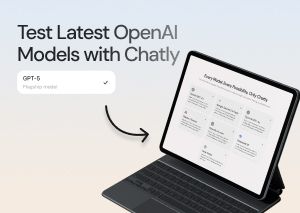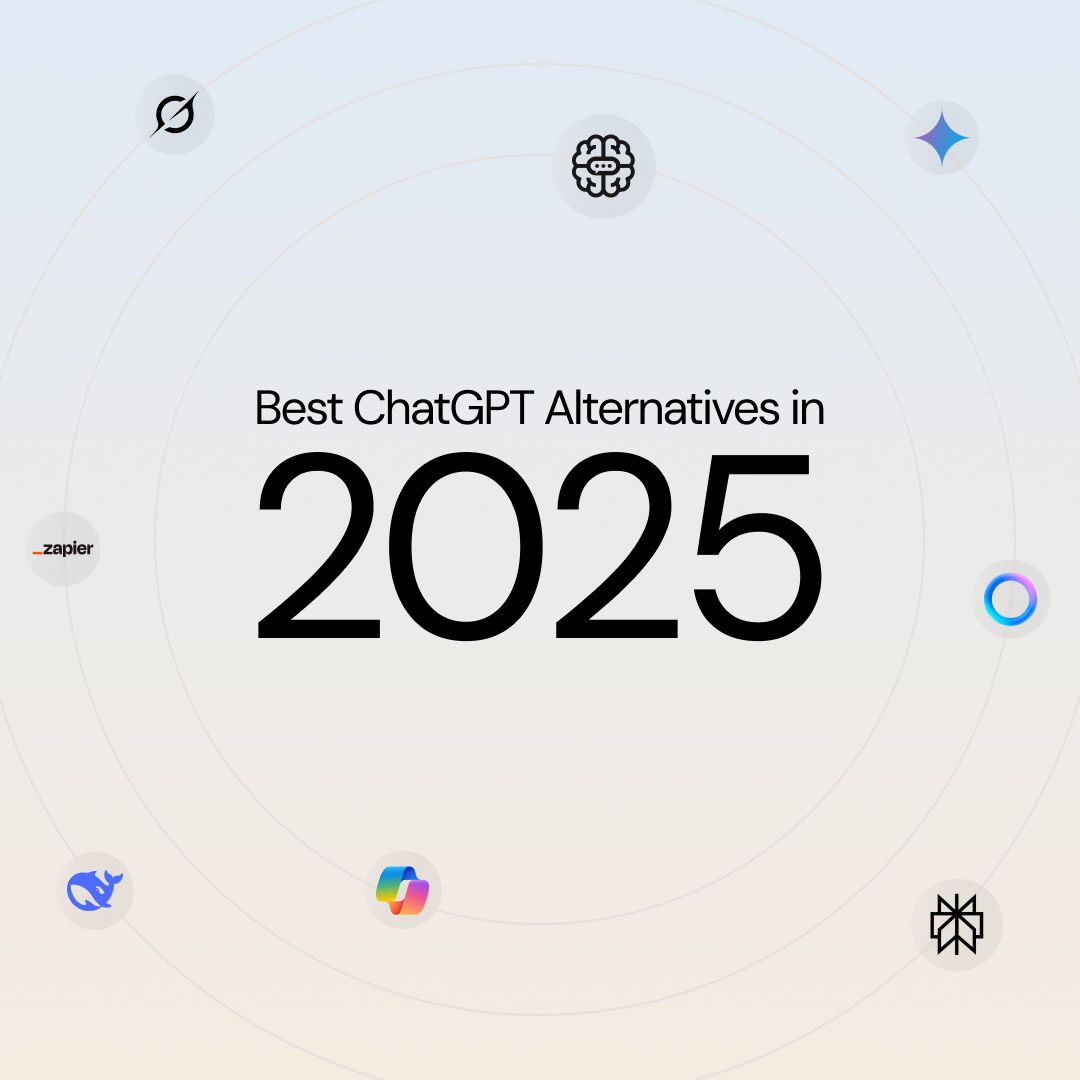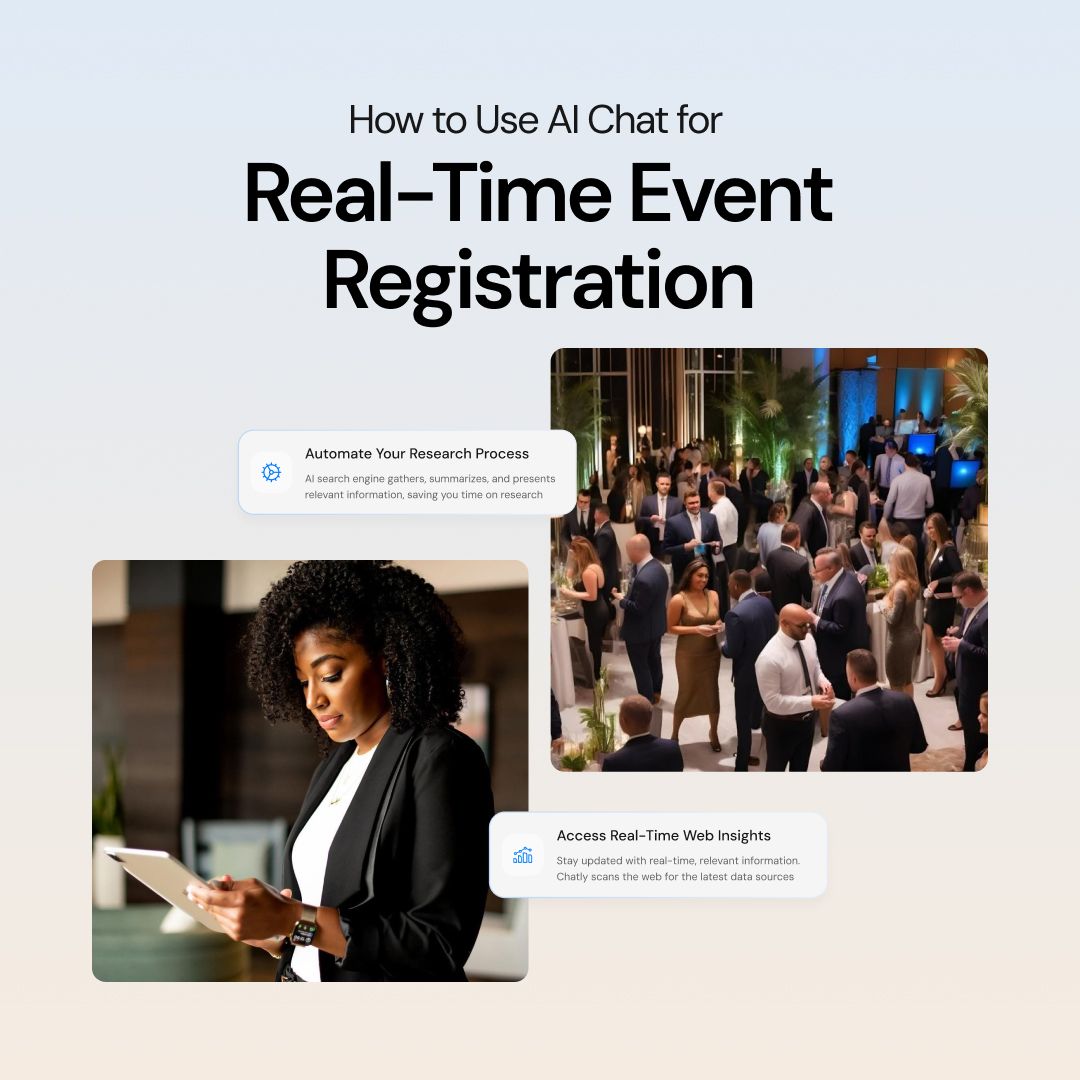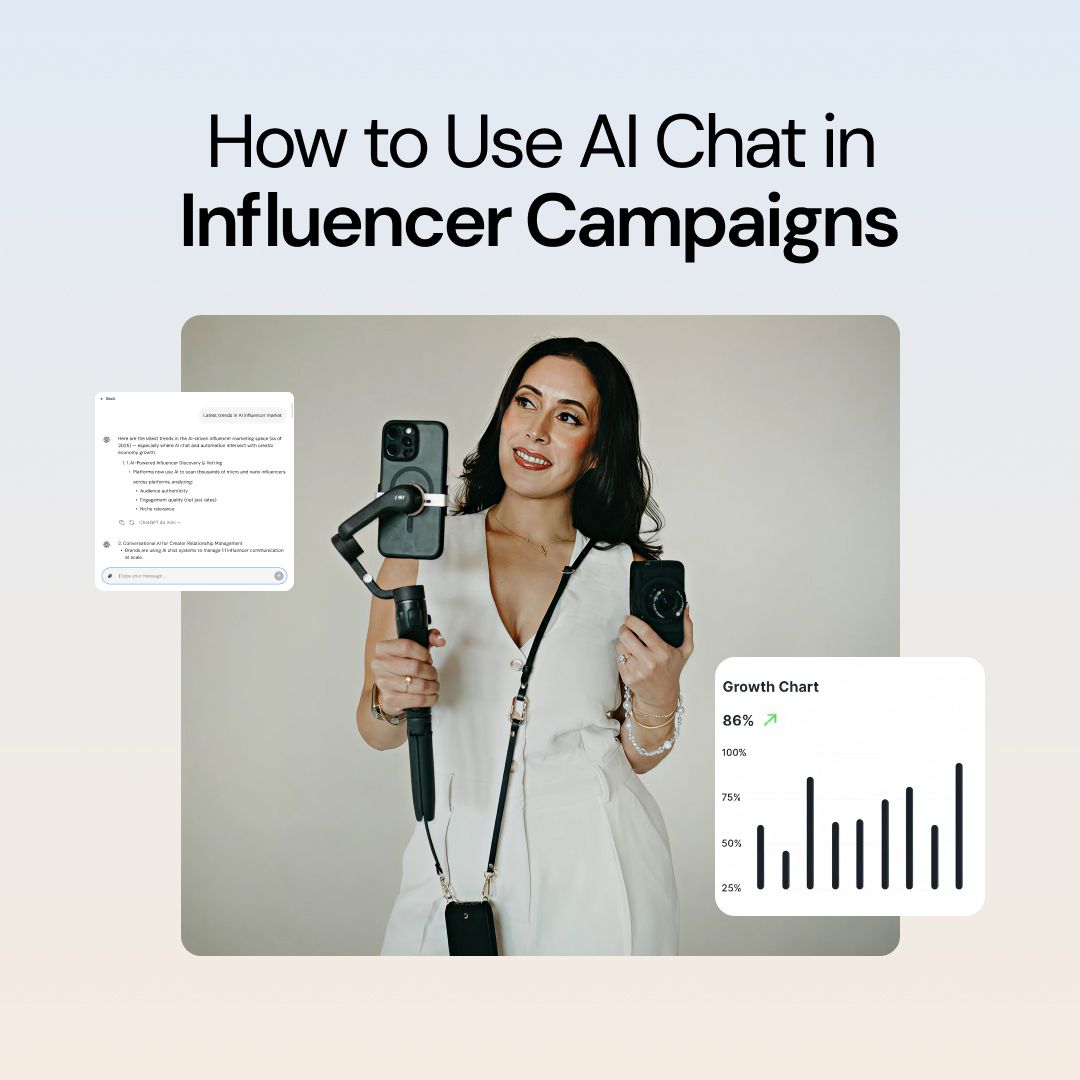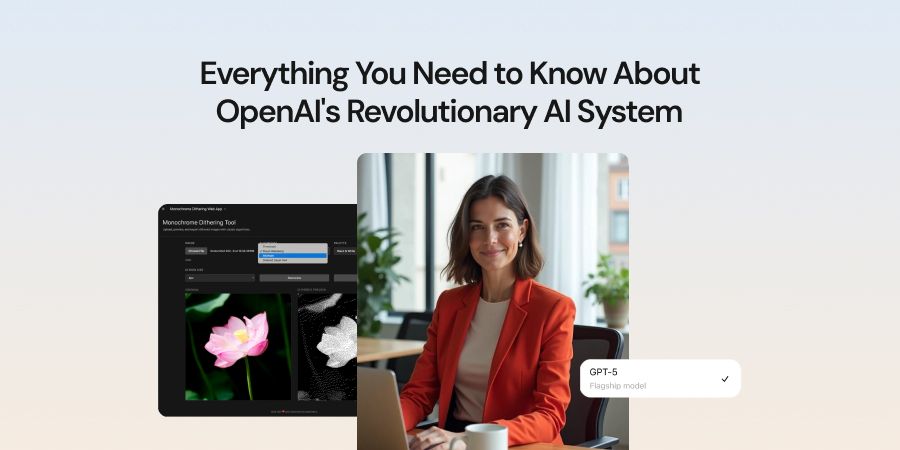
GPT-5 Release - Everything You Need to Know About OpenAI's Latest AI Model
GPT-5 arrives as OpenAI’s most significant step forward. It combines speed, deep reasoning, and strong safety into a single system that adapts to the task at hand.
OpenAI officially released GPT-5 on August 7, 2025. The system introduces a unified architecture that blends fast responses for simple prompts with extended reasoning for complex work. Users no longer need to pick a model or guess the right setting.
The router in GPT-5 does that in real time, guided by signals like complexity, intent, and tool needs. The result is a practical and reliable AI experience across coding, writing, health, and multimodal analysis.
At a glance
-
Unified system that routes between fast and deep reasoning modes
-
Stronger accuracy with reduced hallucinations and clearer limits
-
State-of-the-art performance across math, science, coding, and vision
-
Safer completions that remain helpful within clear boundaries
-
A Pro variant for extended reasoning on high-stakes tasks
Fun fact: Users can nudge deeper reasoning by saying “think hard about this” in the prompt. The router treats this as an explicit signal.
Understanding GPT-5's Unified System
The unified system in GPT-5 consists of three moving parts that work together.
A fast model answers most everyday queries with low latency. A thinking mode engages longer reasoning when problems get hard. A real-time router decides which to use, based on conversation type, complexity, explicit signals, and tool requirements.
This design removes the friction of model selection while improving response quality at scale.
The Architecture Behind GPT-5
The router is the core decision-maker. It learns from real usage to predict which path will be most effective for each request.
GPT-5’s router is continuously trained on actual user behavior, including model-switch patterns, preference signals, and correctness measures. If a user signals depth, the router prioritizes extended reasoning. If a request is straightforward, it directs to the fast model.
Where the router helps most
-
Mixed workloads with variable complexity
-
Teams that need consistency of format and tone
-
Scenarios with tools and APIs that require coordination
-
Long sessions that benefit from context carryover
How Intelligent Routing Works
Routing evaluates complexity, tool needs, and intent in real time, then picks the appropriate reasoning path.
Developers benefit directly. A simple debugging prompt flows to the fast model for speed. A request for a distributed architecture or a multi-step data pipeline auto-routes to deeper reasoning. As more users interact, the router refines its choices, improving performance systemwide without extra prompt engineering.
What’s New in GPT-5 vs GPT-4o and o3
This comparison highlights routing, reasoning, factuality, safety, and cost so stakeholders can see where GPT-5 is materially different and where existing flows may remain unchanged for now.
- Routing: GPT-5 uses a real-time router that selects depth and tools. GPT-4o often required manual choice. o3 had limited depth control.
- Reasoning: GPT-5 provides stronger reasoning with fewer output tokens in thinking. GPT-4o was good. o3 was strong but heavier at depth.
- Coding: GPT-5 shows higher performance on real tasks and better multi-step completion. GPT-4o and o3 were solid but less consistent on long chains.
- Vision: GPT-5 offers higher multimodal accuracy and tighter text to image alignment. GPT-4o and o3 were good but less precise.
- Factuality: GPT-5 reduces hallucinations and states limits more clearly. GPT-4o improved over earlier models. o3 was mixed.
- Safety: GPT-5 favors safe completions that remain useful. GPT-4o often refused. o3 was mixed.
- Cost profile: GPT-5 delivers better results with fewer output tokens. GPT-4o varied. o3 tended to be heavier at depth.
It is advised to keep older flows only where prompts are legally frozen or high-risk automations cannot change yet.
GPT-5 Features That Transform Real-World Applications
GPT-5 raises the bar across coding, writing, healthcare, and multimodal understanding. Each capability is tuned for practical outcomes.
The release focuses on utility. Benchmarks are strong, but the real story is day-to-day reliability. Coding tasks move faster. Business writing reads cleaner. Medical explanations become clearer and safer. Visual comprehension ties images and text together in a single thread.
Revolutionary Coding Capabilities
GPT-5 improves full-stack productivity. It handles large codebases, refactors safely, and follows architectural patterns consistently.
With 74.9 percent on SWE-bench Verified and 88 percent on Aider Polyglot, GPT-5 shows real progress on software tasks that mirror actual developer work. It creates responsive interfaces, understands spacing and typography, and keeps styles consistent across files.
It suggests refactors, flags issues early, and writes tests with context in mind. For full-stack work, it moves between frontend, backend, data, and deployment while documenting choices and enforcing basic security and accessibility practices.
Practical wins
-
Reads and reasons across multi-file projects
-
Suggests precise refactors that maintain behavior
-
Creates tests and docs with minimal prompting
-
Adapts to established styles and linting rules
Advanced Writing and Creative Expression
GPT-5 is among some of the best ai writing tools which turn outlines into publishable drafts and improves clarity without losing voice or intent.
The model sustains consistent tone across long documents. It handles nuanced tasks like unrhymed iambic pentameter and free verse, and it does professional prose with restraint. For business writing, it drafts emails, briefs, and reports in a style that suits the audience, sometimes using AI Chat. It avoids clichés and keeps language clean and direct.
Where it helps writers
-
Turning rough notes into structured content
-
Rewriting for clarity, tone, and audience fit
-
Sustaining voice across long-form documents
-
Producing creative pieces with form awareness
Whether you need a quick cover letter or an optimized research proposal, with AI Chat you have a writing partner that understands your style and executes accordingly.
Healthcare Applications and Medical Support
GPT-5 assists with education and documentation, and it flags when professional care is required.
With a 46.2 percent score on HealthBench Hard, GPT-5 improves both patient education and professional support. It explains tests, outlines follow-ups, and asks clarifying questions. It can summarize literature, surface guidelines, and help format patient-facing materials. It does not replace clinical judgment. It aims to make discussions and decisions more informed.
Safer usage patterns
-
Provide context such as age range and region
-
Ask for clarifications before acting on advice
-
Treat outputs as guidance that needs professional review
-
Use it to improve understanding, not to self-diagnose
Multimodal Understanding and Visual Intelligence
GPT-5 reads charts, diagrams, and images, then ties insights back to text.
With 84.2 percent on MMMU, GPT-5 improves at interpreting visuals. It extracts data from graphs, reads whiteboard photos, and links design mockups to requirements. It can review invoices, discuss blueprints, or annotate screenshots. The benefit is a single conversation that keeps textual and visual context aligned.
Use cases to consider
-
Finance teams reviewing metric dashboards
-
Product teams discussing design revisions
-
Operations teams digitizing paperwork
-
Engineers explaining system diagrams
Breakthrough Performance: GPT-5 Benchmarks and Capabilities
Strong benchmarks indicate real improvements, especially in math, science, and coding.
These scores reflect better reasoning, tighter factuality, and more stable tool use. The model does more with fewer tokens when thinking is engaged, which helps both cost and latency.
State-of-the-Art Academic Performance
GPT-5 performs at expert levels across difficult benchmarks, with strong gains in mathematical reasoning and scientific QA.
GPT-5 achieves 94.6 percent on AIME 2025 without tools. On GPQA, GPT-5 Pro scores 88.4 percent without tools. Together, these scores point to stronger reasoning over structured problems and graduate-level questions. Multimodal performance at 84.2 percent on MMMU supports tasks that span text and images.
What this means in practice
-
Better step-by-step math explanations
-
Stronger synthesis across scientific articles
-
More reliable answers on complex, interdisciplinary prompts
-
Improved grounding when visuals are part of the task
Real-World Coding Excellence
Benchmarks translate to better day-to-day coding outcomes across languages and stacks.
The 74.9 percent success rate on SWE-bench Verified covers real engineering tasks, not toy puzzles. The 88 percent on Aider Polyglot confirms multi-language strength. The model follows instructions, coordinates tools, and finishes multi-step tasks with less back-and-forth.
Developer quality-of-life gains
-
Fewer context resets on large tasks
-
Cleaner diffs with clearer intent
-
Better awareness of performance bottlenecks
-
More consistent adherence to security basics
Efficiency Through Intelligent Reasoning
GPT-5 with thinking outperforms OpenAI o3 while using 50 to 80 percent fewer output tokens across multiple capabilities.
This efficiency lowers cost and speeds up results. It also reduces noise in long sessions. The router’s ability to pick the right depth per query avoids overthinking trivial tasks and underthinking hard ones.
Tips for efficiency
-
State the target depth when it matters
-
Cache reusable outputs like common templates
-
Prefer precise asks over broad fishing expeditions
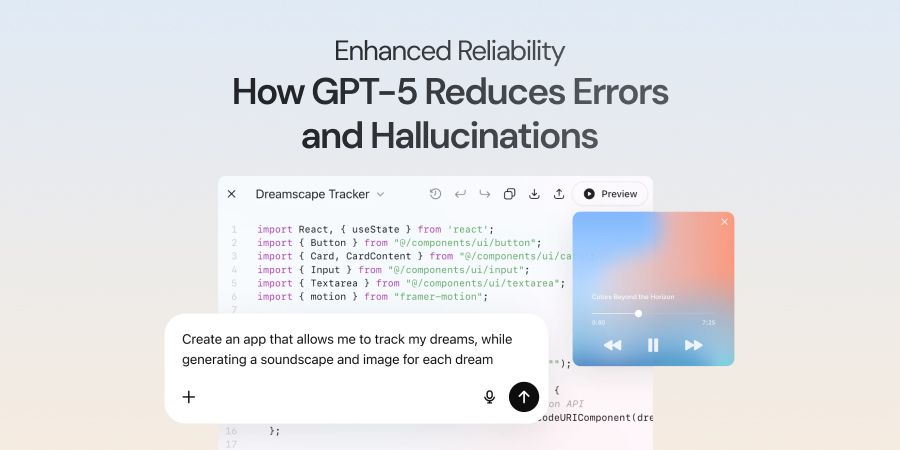
Enhanced Reliability: How GPT-5 Reduces Errors and Hallucinations
Factual accuracy improves, and the model is clearer about limitations.
Testing shows meaningful drops in hallucinations, especially when web search or thinking mode is active. The model also communicates missing inputs more reliably and avoids pretending that a task was completed when it was not.
Dramatic Reduction in Factual Errors
Search-enabled responses are about 45 percent less likely to contain factual errors compared to GPT-4o. Thinking mode shows up to 80 percent fewer errors versus OpenAI o3.
GPT-5 has been trained to prioritize accuracy over confident-sounding guesses. It performs better on open-ended questions and complex fact patterns. On benchmarks such as LongFact and FActScore, GPT-5 thinking shows about six times fewer hallucinations than o3.
Good operational habits
-
Ask for sources when the answer is sensitive
-
Use thinking mode on high-impact queries
-
Prefer explicit constraints and definitions
-
Review critical outputs with human oversight
Improved Honesty and Transparency
The model is better at stating what it cannot do and why.
In tests where images or tools were removed, GPT-5 identified the absence 91 percent of the time, compared to 14 percent for o3. Deception rates in reasoning responses dropped from 4.8 percent in o3 to 2.1 percent. When GPT-5 cannot complete a step, it explains the reason and proposes safe alternatives.
Fun fact: Clear denial with explanation tends to increase user trust and task success on the next prompt.
Addressing Sycophancy and Style
Agreeability is reduced on prompts designed to induce flattery or blind agreement.
Targeted training lowered sycophancy from 14.5 percent to under 6 percent. The writing style avoids excessive enthusiasm and unnecessary emojis. The tone reads closer to a capable colleague who provides direct, considered feedback.
Revolutionary Safety: GPT-5's Safe Completions Framework
Safety shifts from refusal-only to guided, useful responses that stay within strict boundaries.
The safe completion approach identifies the legitimate part of a request and responds with useful, non-harmful content, while explaining why certain details are omitted.
From Refusals to Safe Completions
The model provides educational guidance for dual-use topics while withholding sensitive specifics.
Design choices that help
-
High-level concepts instead of procedural steps
-
Clear rationale for omitted content
-
Redirects to safe documentation where relevant
-
Affirmation of legitimate learning goals
Comprehensive Biological and Chemical Safeguards
OpenAI classifies GPT-5 thinking as High capability in bio and chem domains under its Preparedness Framework, with multiple layers of protection.
The company conducted 5,000 hours of red-teaming with partners such as CAISI and UK AISI. There is no definitive evidence that GPT-5 enables novices to cause severe harm, and the system still applies strong safeguards. The goal is straightforward. Maintain usefulness for research and education while minimizing risk.
Suggested read: Top ChatGPT Alternatives
GPT-5 Pro: Extended Reasoning for Complex Challenges
GPT-5 Pro is built for high-stakes work that benefits from longer, parallel test-time compute.
Advanced users can opt into Pro for deeper thought, stronger coverage, and fewer major errors on complex prompts across health, science, math, and code.
Understanding GPT-5 Pro Capabilities
External experts preferred GPT-5 Pro over standard thinking 67.8 percent of the time across more than 1,000 real reasoning prompts.
The Pro variant reduces major errors by about 22 percent and produces more complete, context-aware answers. It also maintains consistency over long chains of reasoning, which is vital for research, complex design, and strategy.
When Pro shines
-
Scientific literature reviews and synthesis
-
Complex mathematical modeling and proofs
-
Multi-system software and data architecture
-
Legal or policy analysis with layered constraints to assist in matters like writing your own will and exploring loan options
When to Use GPT-5 Pro
Choose Pro when accuracy and completeness matter more than speed.
Typical candidates include strategic planning, advanced research, risk modeling, and major investments. Pro also helps with interdisciplinary questions that span multiple domains, where sustained context retention improves outcomes.
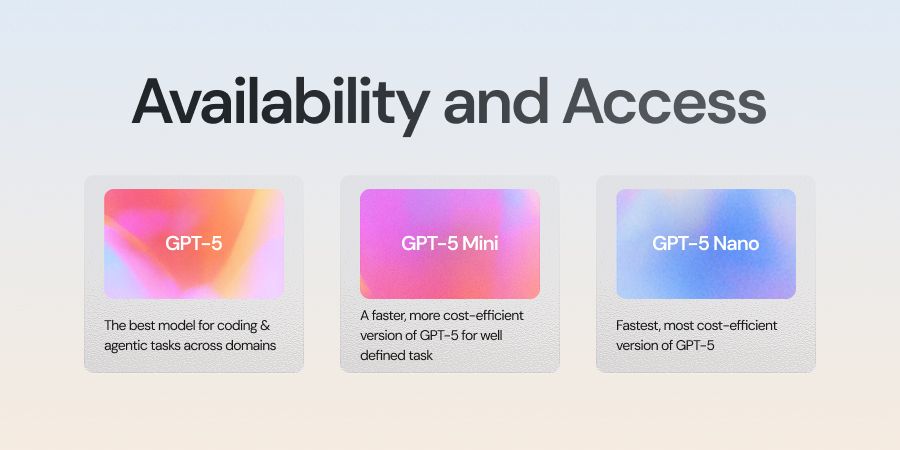
Availability and Access: How to Use GPT-5
GPT-5 is the new default in ChatGPT for signed-in users. Reasoning depth is auto-managed, with the option to explicitly invoke thinking.
The rollout consolidates multiple legacy models into a single experience. Free users get GPT-5 with limits, then move to GPT-5 mini. Paid users can select GPT-5 Thinking or GPT-5 Pro for guaranteed depth.
ChatGPT Integration and Rollout
GPT-5 became the default model for all signed-in users on August 7, 2025.
Users do not need to manage model selection for most tasks. The router calibrates depth to the prompt. Paid users can force deeper analysis through the model picker or by stating the requirement directly in the prompt. Full reasoning access for the free tier may take a few days to complete.
Quick usage tips
-
Say “think hard about this” for deep mode
-
Provide minimal but precise context
-
Set expected format upfront
-
Ask for citations when needed
Subscription Tiers and Benefits
Plans map to usage frequency and depth needs.
-
Free Tier. GPT-5 with usage limits, falls back to GPT-5 mini when limits are reached. Good for exploration and casual use.
-
Plus. Higher usage limits for regular personal and professional work. GPT-5 is available by default.
-
Pro. Unlimited access to GPT-5 and access to GPT-5 Pro for extended reasoning. Suited to research and complex decisions.
-
Enterprise and Edu. Rolling out one week after release with dedicated infrastructure, advanced security, and compliance needs.
Pricing and Plan Fit
Matching plans to usage prevents overspend and misconfiguration. Use this chooser to align depth needs, collaboration, and governance with the right tier.
Quick chooser
-
Use Free for occasional tasks and learning.
-
Use Plus for daily drafting, coding support, and research synthesis.
-
Use Pro for extended reasoning, complex multi-step work, and critical decisions.
-
Move to Enterprise or Edu if you need SSO, data residency, and compliance guarantees.
Developer Access and API Integration
Developers can access GPT-5 through the ChatGPT sign-in with the Codex CLI, and through API endpoints aligned to performance and cost needs.
GPT-5 follows instructions reliably, orchestrates tools, and manages multi-step workflows. It fits well into applications that need reasoning, structured outputs, and stable formatting. For larger builds, it coordinates code generation, testing, and documentation while respecting repository conventions.
Developer starter checklist
-
Define schema and output formats early
-
Provide tool manifests and capability hints
-
Use unit tests to anchor behavior
-
Log router depth and review patterns monthly
Migration Guide
A stepwise process reduces risk during the shift to GPT-5. It anchors quality with frozen examples, validates performance with side-by-side tests, and phases change with a clear rollback.
-
Inventory prompts and outputs that are business-critical.
-
Freeze examples of gold-standard outputs for comparison.
-
Run side-by-side tests on ten high-value tasks for one week.
-
Measure accuracy, rework, latency, and token use.
-
Standardize winning prompts, add reviewer checklists, and document limits.
-
Switch traffic in phases with a rollback plan and a dated change log.
Implementation Strategies for Organizations
A structured rollout maximizes benefits and minimizes risk. Start small, measure results, then expand where the system delivers clear value.
Success depends on careful scope, governance, and training. Teams need clarity on what good looks like, which tasks get automated, and which outputs require human review.
Planning Your GPT-5 Deployment
Focus on high-impact use cases that map to GPT-5’s strengths, then scale through templates and playbooks.
Pilot in domains such as code review, knowledge synthesis, and structured drafting. Set baseline metrics before the pilot begins. Track defect rates, cycle times, and satisfaction. Review router behavior to tune prompts and workflows. Establish clear policies for acceptable use and data handling.
Pilot ideas
-
Code review with test generation and refactor suggestions
-
Proposal and brief drafting with fact-check steps
-
Research synthesis with citation checks
-
Customer support summary and triage
Integration Patterns
Choose an integration style that matches risk and complexity. These patterns show how to add GPT-5 to products and workflows while keeping control, traceability, and quality.
-
Human in the loop
GPT-5 drafts, a reviewer approves, and the system publishes. Use this where outputs affect customers, auditors, or regulators. -
Tool-orchestrated agent
GPT-5 calls tools with scoped permissions and logs every step. Use this for repetitive work with clear rules and measurable outcomes. -
**API-first micro-service ** GPT-5 sits behind a stable schema and contract. Multiple apps call the same reasoning service for consistent results.
Observability tips: log router depth, token use per request, and tool results. Alert on unusual spikes and repeated failures.
Training and Change Management
Provide role-specific guidance and clear operating rules. Show quick wins, remove friction, and reinforce responsible use.
Training essentials
-
Short primers on prompting and formats
-
Domain-specific examples and templates
-
Escalation paths for sensitive cases
-
Clear rules for tool use and data sharing
Measuring ROI and Success
Measure productivity, quality, and satisfaction. Do not rely on anecdotes.
Track time saved on routine tasks and reduction in errors. For engineering, measure bug catch rates, time to merge, and post-release incidents. For content, measure revision cycles, clarity scores, and engagement. Monitor quality improvements that reduce rework. Add softer metrics like team stress levels and capacity for strategic work.
Common KPIs
-
Cycle time reduction and throughput gains
-
Error rate reduction and quality uplift
-
Cost per deliverable and token spend
-
Employee NPS and satisfaction trends
Suggested read: Using AI Chat for Influencer Campaigns
Industry-Specific Applications and Use Cases
Each sector can adapt GPT-5 to its own constraints and targets. Start with controlled scopes, then expand.
Use central patterns such as prompt templates, structured outputs, and human-in-the-loop reviews. Tune governance to the sector’s regulatory and risk profile.
Financial Services and Investment
GPT-5 improves analytics, compliance, and client service with better accuracy and traceability.
Investment teams use GPT-5 to process earnings, summarize macro signals, and explore scenarios. Risk teams monitor exposures and test mitigation options. Compliance teams track rules across jurisdictions and keep policies current. Client service improves with clearer explanations and faster turnaround, while respecting boundaries around sensitive information.
Quick wins
-
Automated earnings digests for coverage lists
-
Policy updates mapped to new regulations
-
Portfolio commentary with risk flags
-
Client FAQ generation with audit trails
Healthcare and Medical Research
GPT-5 supports clinicians and researchers with clearer summaries and better context handling.
Researchers use GPT-5 Pro to review literature and draft protocols. Clinicians use GPT-5 to create patient education materials tailored to understanding levels. Patients use it to prepare for appointments and interpret test reports. Safety remains central. Human judgment is required for diagnosis and treatment.
Recommended flows
-
Intake questions that clarify context and risk
-
Research synthesis with citations and limitations
-
Patient leaflets with plain-language summaries
-
Flags that recommend professional review
Education and Academic Research
Personalized learning and rigorous research assistance are now practical at scale.
GPT-5 adapts content to student level, creates exercises, and explains concepts with stepwise logic. It supports researchers with literature mapping, draft reviews, and data interpretation. Teachers save time on lesson planning and grading. Students get clearer pathways through complex topics.
Ideas to pilot
-
Course outline generation with assessment rubrics
-
Lab report feedback against stated criteria
-
Reading list summaries with key themes
-
Thesis chapter planning with scope control
Legal and Compliance
Document-heavy work gets faster and more thorough without sacrificing rigor.
GPT-5 analyzes contracts, identifies risk, and suggests edits that match preferred clauses. It maps case law to arguments and keeps track of jurisdictional variations. Compliance monitoring becomes more proactive, with clearer links from rule change to policy update and control checklist.
Common patterns
-
Clause extraction with risk tags
-
Position papers with cited references
-
Due diligence summaries with cross-document checks
-
Ongoing rule tracking with change logs
Best Practices for GPT-5 Implementation
Good practice reduces noise and improves outcomes. Treat prompts and outputs like product surfaces.
Organizations that standardize formats and reviews see better results, less rework, and easier audits.
Optimizing Prompts for the Unified System
Structure matters. Be explicit about depth, scope, and output shape.
State what you need, who it is for, and how it should look. For deeper analysis, request it directly. For faster answers, simplify the ask. Provide small context blocks instead of flooding the model. Iterate with short turns to align early, then scale the task.
Prompt patterns that work
-
Role, audience, goal, and constraints
-
Input schema and output schema
-
Examples of good and bad responses
-
Depth signals such as “stepwise analysis required”
Managing Costs and Performance
Use depth only when needed. Reuse work. Cache results. Batch where possible.
Cost control checklist
-
Track token spend by team and use case
-
Review top-depth prompts each month
-
Add caching at the application layer
-
Create reusable prompt and output libraries
Security and Governance Considerations
Treat GPT-5 like a powerful system that touches sensitive workflows. Control access and watch the logs.
Define allowed use cases and data classes. Restrict sensitive data from AI processing where required. Monitor for prompt injection and data exfiltration risks. Establish incident response steps. Train power users to recognize risky patterns.
Governance essentials
-
Role-based access and clear approvals
-
Data classification with guardrails
-
Logging, review, and alerting on anomalies
-
Periodic audits and tabletop exercises
Future Implications and Industry Impact
GPT-5 changes how knowledge work is organized and delivered. The shift is from task automation to workflow augmentation.
Teams that adopt early and thoughtfully will build durable advantages. The talent mix evolves toward roles that combine judgment, creativity, and stakeholder leadership with AI fluency.
The Transformation of Knowledge Work
Workflows become more exploratory, thorough, and documented.
Professional services firms refocus junior time on client-facing and strategic tasks. Small businesses gain access to capabilities that used to require large teams. Individuals move faster with better quality and less repetitive work. Education starts to emphasize AI collaboration, data literacy, and structured thinking.
Signals to watch
-
Higher client expectations for turnaround and depth
-
Wider use of AI-generated first drafts with human edits
-
New billing models that reflect outcome quality
-
Job descriptions that require AI proficiency
Building AI-Native Organizations
AI-native means processes are designed for human plus AI collaboration, not retrofitted later.
Decision forums include AI analyses as standard inputs. Boards ask for scenario sets and risk maps created with GPT-5 Pro. R&D teams run more experiments, since prototypes are quicker to build. Org structures flatten where information access and synthesis are no longer bottlenecks.
Operating principles
-
Human accountability with AI support
-
Documentation as a first-class output
-
Reusable components for prompts and pipelines
-
Continuous learning loops across teams
Preparing for Continuous Evolution
Models will continue to consolidate and improve. Build systems that adapt to change.
Readiness checklist
-
Versioned prompts and templates
-
Model abstraction layers in code
-
Training that is refreshed quarterly
-
Regular reviews of safety, cost, and quality
Quick Reference Guides
Short, practical lists that help teams operationalize GPT-5.
Prompt Design Cheat Sheet
Use this as a starting set, then localize for your team.
-
State role, audience, and goal in one sentence
-
Provide input and output schemas
-
Ask for stepwise reasoning only when needed
-
Show one good example and one bad example
-
Set evaluation criteria such as accuracy and tone
-
Request citations where required
-
Specify length and format limits
Developer Integration Checklist
Keep the surface stable even as models evolve.
-
Define contracts for inputs and outputs
-
Use function calling or tool definitions where possible
-
Log router depth, token use, and latency
-
Add caching for templates and common outputs
-
Write unit tests for critical generations
-
Separate model keys and secrets from app code
-
Review logs for prompt injection patterns
Governance and Safety Guide
Protect data and maintain trust without blocking progress.
-
Maintain a register of approved use cases
-
Classify data and restrict sensitive categories
-
Require human review for critical outputs
-
Audit logs monthly and sample conversations
-
Train users to spot risky requests
-
Document incidents and lessons learned
Conclusion
The GPT-5 release marks a clear step forward for everyday work. OpenAI GPT-5 features deliver quick, accurate responses for simple requests and shift into deeper reasoning when a problem is complex.
There is no need to manage settings or switch models. Ask the question and the system adapts. Writing reads cleaner and more consistent. Code reviews move faster with clearer diffs and better tests. Images, charts, and notes can live in the same conversation without breaking context. When the stakes are high and completeness matters, GPT-5 Pro provides the extra depth needed to make confident decisions.
Progress should be easy to demonstrate. Choose a few real tasks that repeat each week and save strong before examples. Run the same tasks with GPT-5 and compare the results side by side. Look for fewer edits, shorter turnaround, clearer structure, and steadier quality.
If the gains are not obvious, adjust the prompt, tighten the brief, and try again. Teams see rapid improvement when they treat GPT-5 like a standard tool in the workflow, measure outcomes, and refine in small steps.
Here's a short plan that helps you get value fast:
-
Choose three use cases you repeat every week.
-
Write a one-paragraph brief for each task and keep the output format consistent.
-
Ask for sources when facts matter and keep a light review step.
-
Track time saved and decide where GPT-5 Pro is worth it.
Frequently Asked Questions Related to GPT-5 Release
Brief answers to the most common questions we get related to OpenAI GPT 5.
More topics you may like

